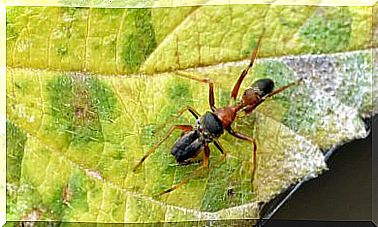Causes And Treatments Of Urticaria In Dogs

Hives in dogs appear as reddish welts on the skin that can cause itchiness. It is usually caused by a reaction that allergic dogs are prone to.
Hives are very common and usually go away on their own in a short time. However, when the case is serious, it is necessary to see a veterinarian urgently so that he can provide an oral or injectable antihistamine.
Causes of urticaria in dogs
In dogs, skin pathologies are usually related to environmental allergens and usually appear in specific areas, such as the face, ears, legs, base of the tail, under the elbows and in the groin area.
They present as swelling, lumps, itching, burning, discomfort and nervousness.
Therefore, urticaria is a hypersensitive response to some external agent, such as:
- A type of food.
- Vaccines or certain medications.
- Plants like nettles.
- The sting of an insect. Fleas, lice and mites can cause skin irritations. Some dogs are very sensitive to them.
- Infections.
- Allergies.
- Excessive cold or heat. It is a group of urticarias in which redness appears in the region of contact with very low or very high temperatures.
- Skin diseases.

It is easy to detect hives because they are very eye-catching. In short- haired dogs, it is possible to observe an increase in the hair in the lesions, which gives the coat a grainy appearance.
They don’t always itch, but when they do, it’s very obvious: the dog scratches himself very intensely and can cause injuries. Hives in dogs appear more often in short-haired breeds.
How to treat hives in dogs?
It is very important to find the cause of urticaria to avoid, in the future, the element that produces it, and it is necessary to eliminate it from the animal’s food or ensure that it does not come into contact with the animal’s skin again.
Depending on how severe the urticaria is, or how often it occurs, we should think about whether our dog needs any long-term treatment.

There are different tests and exams to detect which elements cause allergies in a dog. These tests include environmental agents such as certain types of pollen, plants, mites… and foods such as meat, fish, rice, wheat or eggs.
Immunotherapy treatments are also available to treat allergies through monthly vaccinations.
anaphylactic shock
If the urticaria reaction does not subside and you notice that the dog is getting worse and may be experiencing anaphylactic shock, you need to see a veterinarian urgently.
Such cases may require hospitalization until the crisis is resolved, in addition to antiserum and intravenous medication. In these situations, we should never wait or administer medications on our own.
The skin is the first barrier against infections, parasites and disease. Therefore, it is very important to take care of it to maintain a strong immune system. In addition to applying good hygiene, we can help our dog with a complete diet and nutritional supplements.
Foods rich in omega 3 and omega 6 fatty acids are beneficial for animals prone to dermatitis and allergic skin reactions.









